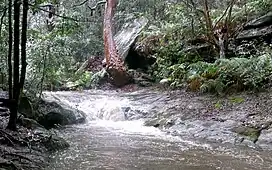Cammeraygal
The Cammeraygal, variously spelled as Cam-mer-ray-gal, Gamaraigal, Kameraigal, Cameragal and several other variations,[1][2] are one clan of the 29 Darug tribes who are united by a common language, strong ties of kinship and survived as skilled hunter–fisher–gatherers in family groups or clans that inhabited the Lower North Shore of Sydney, New South Wales, Australia.[3]
| Cammeraygal people | |
|---|---|
| aka: Cam-mer-ray-gal, Camerray-ga, Camera-gal, Cammeraa, Cam-meray, Kemmirai-gal, Gamaraigal, Cameragal, Kem:arai, Kemmaraigal and Kameraigal (referring to a group) (AIATSIS), nd (SIL)[1][2] | |
 The traditional lands of the Cammeraygal people were located in the Sydney Basin bioregion | |
 A cave known to shelter Cammeraygal people at Chatswood West | |
| Hierarchy | |
| Language family: | Pama–Nyungan |
| Language branch: | Yuin–Kuric |
| Language group: | Yora |
| Group dialects: | Dharug (also called Eora)[2] |
| Area | |
| Bioregion: | Sydney Basin |
| Location: | Lower North Shore of Sydney, New South Wales, Australia |
| Coordinates: | 33°50′S 151°12′E |
| Urban areas | |
| Notable individuals | |
| |
Traditional lands
The traditional lands of the Cammeraygal people are now contained within much of the North Sydney, Willoughby, Mosman, Manly and Warringah local government areas.[4][5][6] The Cammeraygal people lived in the area until the 1820s and are recorded as being in the northern parts of the Sydney region for approximately 5,800 years.[7]
Legacy
The suburb of Cammeray and Cammeraygal High School, located in the suburb of Crows Nest, are named after the Cammeraygal people. The name Cammeraygal is ensigned on the North Sydney Council emblem. In 1999, North Sydney Council erected a monument in honour of the Cammeraygal tribe, the traditional owners of the North Sydney area.[8]
Notable Cammeraygal people
- Barangaroo, the second wife of Bennelong[9][10]
Notes
Citations
- Dousset 2005.
- AIATSIS 2012.
- Attenbrow 2010, p. 22.
- CMS 2013.
- UoS 2014.
- Walker 2008.
- Hoskins 2019.
- Monuments Australia 1999.
- Collins, sub. V.
- BDA 2011, p. 7.
Sources
- "1790s". A history of Aboriginal Sydney. University of Sydney. 11 July 2014. Retrieved 22 April 2015.
- Attenbrow, Val (2010). Sydney's Aboriginal past: investigating the archaeological and historical records. Sydney: UNSW Press. p. 22. ISBN 978-1742231167. OCLC 659579866.
- "Barangaroo, a Cameragal woman of courage" (PDF). Annual Report. Sydney: Barangaroo Delivery Authority. 2011. p. 7. Archived from the original (PDF) on 20 March 2012. Retrieved 23 January 2012.
- "The Cammeraygals". Monuments Australia. 1999. Retrieved 22 April 2015.
- Collins, David. "Appendix". An account of the English Colony in New South Wales (PDF) (PDF). Vol. 1. sub. V. ISBN 0-589-07168-8.
- Dousset, Laurent (2005). "Eora". AusAnthrop Australian Aboriginal tribal database. Archived from the original on 16 October 2014. Retrieved 22 April 2015.
- "History". Cameragal Montessori School. 2013. Retrieved 22 April 2015.
- Hoskins, Ian (2019). "Aboriginal North Sydney" (requires download) (PDF). North Sydney Council. Retrieved 22 April 2022.
- "Language information: Eora". Australian Indigenous Languages Database. AIATSIS. 26 June 2012. Retrieved 22 April 2015.
- Tindale, Norman Barnett (1974). "Eora (NSW)". Aboriginal Tribes of Australia: Their Terrain, Environmental Controls, Distribution, Limits, and Proper Names. Australian National University.
- Walker, Frank (13 July 2008). "Ancient spirits lifted". The Sydney Morning Herald. Retrieved 22 April 2015.